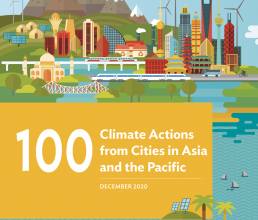First appeared in

Asian Development Bank
100 Climate Actions from Cities in Asia and the Pacific
The Wuhan Model looks across sectors to peak emissions in the mega-city by 2022, eight years ahead of the national target.
The Wuhan Model looks across sectors to peak emissions in the mega-city by 2022, eight years ahead of the national target.
The so-called Wuhan Model targets the six areas of industry, energy, life, ecology, infrastructure and demonstration for low-carbon developments and initiatives. Some highlights from the far-reaching model include low-carbon agriculture, priority to non-fossil energy, low-carbon transportation, greening of the city, and creating low-carbon demonstration projects to improve the reach of the project and scale it to other cities. It is the first carbon emission peak action plan proposed at the city level in the PRC.
41%
GREEN COVERAGE RATE IN URBAN AREAS
In 2018 the city was on course for emissions of 155 million tons of CO₂ equivalent, but following the initiatives across the different sectors the city estimates to have saved over 16 million tons of CO₂ equivalent. This has also benefited the city’s air quality, which has seen a 35% improvement compared with 2013.
As Wuhan and the PRC’s economies continue to grow, it is vital that they can decouple emissions from growth to help mitigate climate change. By 2022 the city aims to peak at 173 million tons, after which it aims to decrease them towards 2030 and beyond.

The action plan is composed of six major projects and can be used as an example of successful low-carbon development for other cities in the PRC (photo by Fan Jianjun).
The Challenge
As a large city, Wuhan has previously experienced an increase in the growth rate of urban carbon emissions.
Co-Benefits
Social The low-carbon transformation of the city will improve livability with more efficient public transport, green spaces, and improved infrastructure.
Environment The project will reduce coal consumption and emissions in Wuhan, with corresponding pollutants falling by 19% compared to 2015.
Health Reduced pollution will reduce the number of deaths related to poor air quality by about 50,000.

